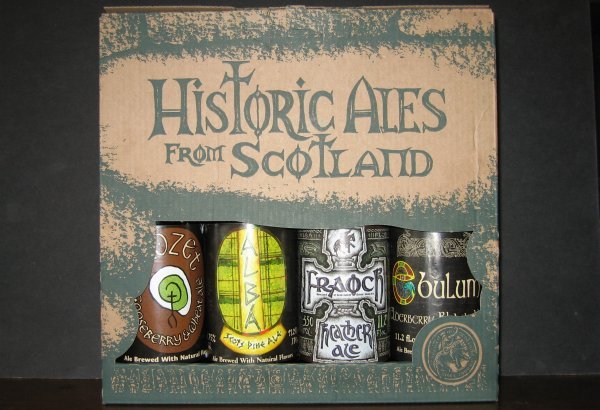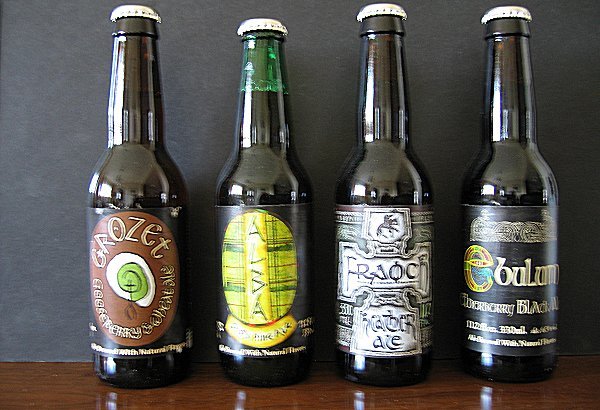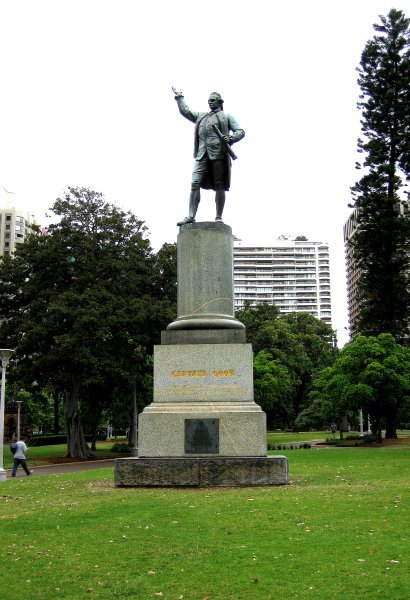|
Tossing The Caber
The Caber (Compiled by J. Douglas Ross from several sources,
Heavy Events originated in Scotland during the reign of Malcolm Canmore (Ceann Mor = "big head") in the 12th century. King Malcolm discouraged the playing of golf in favour of practising activities related to the battlefield. Aside from archery, the oldest contests consisted of a Stone Put, Hammer Throw and Caber Toss. The king encouraged the formation of clans and competitions between rivals. Many believe that the Caber Toss came from the practice of throwing logs across the moat of a castle or placing logs for climbing when storming the walls. A more likely explanation is that it was a simple sport amongst foresters.
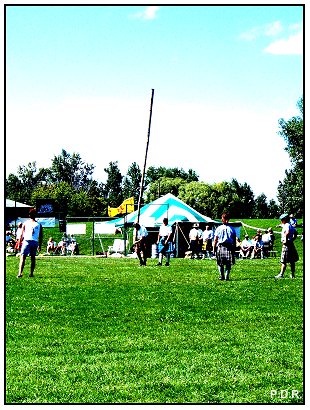 Centuries passed and, as the Highland Games became more popular, classifications were added for weight and height and distance as well as the more recent introduction of the favourite Canadian Sheaf Toss. There was little historical mention of Track-and-Field, a Tug-of-War or the Hill Race, but the most popular and exciting games list a complete array of contests. Nevertheless, the Caber Toss (or cabar in Gaelic, meaning "tree") is the best known icon of all.
Centuries passed and, as the Highland Games became more popular, classifications were added for weight and height and distance as well as the more recent introduction of the favourite Canadian Sheaf Toss. There was little historical mention of Track-and-Field, a Tug-of-War or the Hill Race, but the most popular and exciting games list a complete array of contests. Nevertheless, the Caber Toss (or cabar in Gaelic, meaning "tree") is the best known icon of all. Perhaps the Caber is best described as a baby telephone pole with a typical length of 18 feet (5.5 m) and average weight of 150 lb (68 kg), but sizes up to 25 feet (7.62 m) weighing 280 lb (127 kg) have been known in heavyweight competitions. The weight was often regulated before the games by soaking a dried caber in a nearby loch. If the caber was not thrown in certain heavyweight games, an old-fashioned crosscut saw was used by top competitors to saw a couple of centimetres from the pole until one of them accomplished the toss, although points may also be awarded for the number of degrees a caber rotated if it was short of the required 90 degrees (i.e. a "Fifer"). A description of the Caber Toss is deceptively simple. The contestant must heft the pole into a perpendicular perfectly-balanced "walking" position from which it is tossed after a few steps forward. While style, timing and momentum play an important role, they are not part of the score. The distance that the caber is thrown does not matter either. The athlete tries to throw the caber through 90 degrees so that the heavy end strikes the ground and the narrower end ideally carries over in an arc and lands flat out from him/her at an imaginary 12 o'clock position. The main judge must make that call just at the precise moment the pole hits the ground. As noted, a "Fifer" is a term used by a second judge when the pole did not rotate through a full 90 degrees. The most famous of the Highland Games is The Braemar Gathering, which became The Royal Highland Gathering in 1866. In the following photo, two contestants carry a standard Braemar Caber, 6 m (19.75 ft. long) and weighing 59.9 kg (132 lb), onto the field in Braemar while the Queen reviews the Canadian Massed Pipe and Drums Band from the Royal Box. [In 2006, H.M.Queen Elizabeth designated the yearly Nova Scotia International Tattoo as "Royal".] 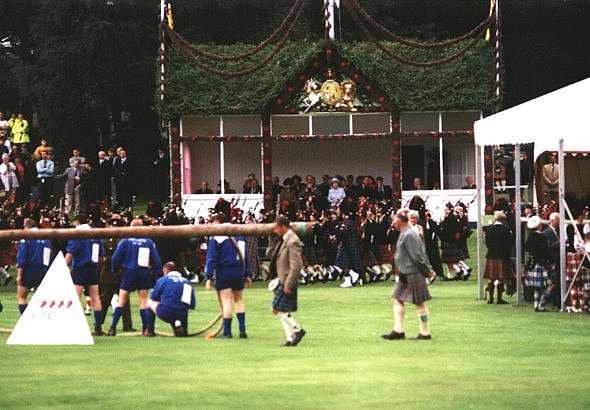
SCOTLAND'S HISTORIC ALES
Scotland's national beverage may truly be Scotch Whisky, but another historic icon would have to be the fermented ales introduced by the Druids, Picts, Celts and Vikings (from as early as 2000 B.C. in the case of Scotland's native beer . . . Heather Ale). Besides, this topic gave me an opportunity to review applicable units of liquid measure such as the firkin (one-quarter of a barrel) and the kilderkin (one-half of a barrel); in today's terms, a kilderkin would be 41 litres or 9 imperial gallons or 10.8 of the smaller US gallons. All of the ales described below may be purchased by the firkin, but the percentage alcohol by volume is generally a bit lower than the bottled versions.
In case anyone is interested in setting up a party for those who might enjoy an ancient beer or twa, Pat and I enjoyed four of the five Historic Scottish Ales described at a webpage in the Links To All Things Scottish at our Clan Ross - Canada site. Both of us enjoyed the chilled, amber-coloured Fraoch or Heather Ale 5%abv most of all. The Kelpie or Seaweed Ale had the least alcohol by volume (4.4%), but it was omitted from the selection . . . probably because it was the least favourite due to its association with the salty sea breeze. It is said that Robbie Burns enjoyed the pale Grozet with his friends, and we would give it a close second in our choice since it was not too different from other 5%abv pale ales on the market . . . aside from its wee fruit aroma. The chilled Ebulum was a stronger dark ale (6.5%abv) fermented with ripe elderberries and retained a very wee bit of the fruit favour . . . which was said to be used at community gatherings in the Scottish Highlands for over seven centuries. Alba, best at room temperature, was the strongest ale at 7.5% alcohol by volume . . . and used (so it is said) by Captain Cook to prevent scurvy and illness on long voyages; Pat and I noted a slightly bitter aftertaste . . . possibly because we were not at sea and had a better selection of ales. GROZET (Gaelic for gooseberry): Lager malt is brewed with malt, bog myrtle, hops and meadowsweet. Then gooseberries are added for a second fermentation. ALBA (a name for Scotland at the time of the Viking raids): Sprigs of pine are boiled for several hours with malted barley during the early Spring. Then fresh shoots of spruce needles are briefly infused before the fermentation process. FRAOCH (Gaelic for heather): A boiling brew of malted barley, sweet gale and flowering heather produces a spicy aroma. It is cooled slightly, but poured while still hot into a vat containing fresh heather flowers . . . where it infuses for an hour before fermentation. EBULUM (derived from a term for elderberries and introduced by 9th century Druids): A 16th century recipe included roasted oats, barley, wheat and herbs, which were fermented with ripe elderberries. KELPIE (seaweed): The malted barley grown on seaweed beds produced interesting flavours in the ale and whisky made by coastal farmers at least 400 years ago. Bladderwrack seaweed was included with the barley in the mash, thus producing this dark ale. The company, Heather Ale Limited, in order to promote consistency in the product, now picks their wild ingredients and freezes them for use throughout the year. These ingredients include heather, meadowsweet, pine, spruce, seaweed, elderberries and gooseberries. The preceding photo was taken in Hyde Park, Sydney, Australia, across the street from Australian Museum on a rainy day. The plaque states: "This statue was erected by public subscription assisted by a grant from the New South Wales Government. 1879". One reference states, "Botany Bay is the place where Lieutenant James Cook landed in April 1770 -- there never was a Captain Cook on the Australian mainland, though he was a captain when he later visited Tasmania and New Zealand -- with his friends and crew on board the barque Endeavour. Two of his companions, Daniel Solander and Joseph Banks, were botanists, and they were entranced by the number of flowers blooming in what the calendar said was our late autumn. But while they were very good at collecting and identifying plants, the two were less effective in identifying good farming land."
The Drink That Satisfies
Drambuie (From the Highlands and Islands Tour of 2007) In 1746, Prince Charles Edward Stuart fled to the isle of Skye. There, he was given sanctuary by Captain John Mackinnon. After staying with the Captain, the prince rewarded him with the prized drink recipe for Drambuie. The original recipe was given in the late 19th century by Capt. MacKinnon to James Ross, who ran the Broadford Hotel on the Isle of Skye. James developed and improved the recipe (initially for his friends locally). It was one of these friends who coined the name, meaning "the drink that satisfies". Ross then sold it further afield even to France and the USA. It was Ross who patented it in London. Tragically he died young, and to pay for their children's education, his widow was obliged to sell the recipe, by coincidence to a different MacKinnon family, in the early 20th century. The Mackinnon family has been producing the drink ever since. The first commercial distribution of Drambuie in Edinburgh was in 1910. Only twelve cases were originally sold. In 1916, Drambuie became the first liqueur to be allowed in the cellars of the House of Lords, and Drambuie began to ship world wide to stationed British soldiers. In the 1980s, the producers of Drambuie began to advertise the liqueur. MEMORIAL INSCRIPTION: Erected to/ the Memory of /James Ross/ Broadford, Skye/ by his/ Many Friends and/ Acquaintances/ as a Token of Their Esteem. 1845-1902. 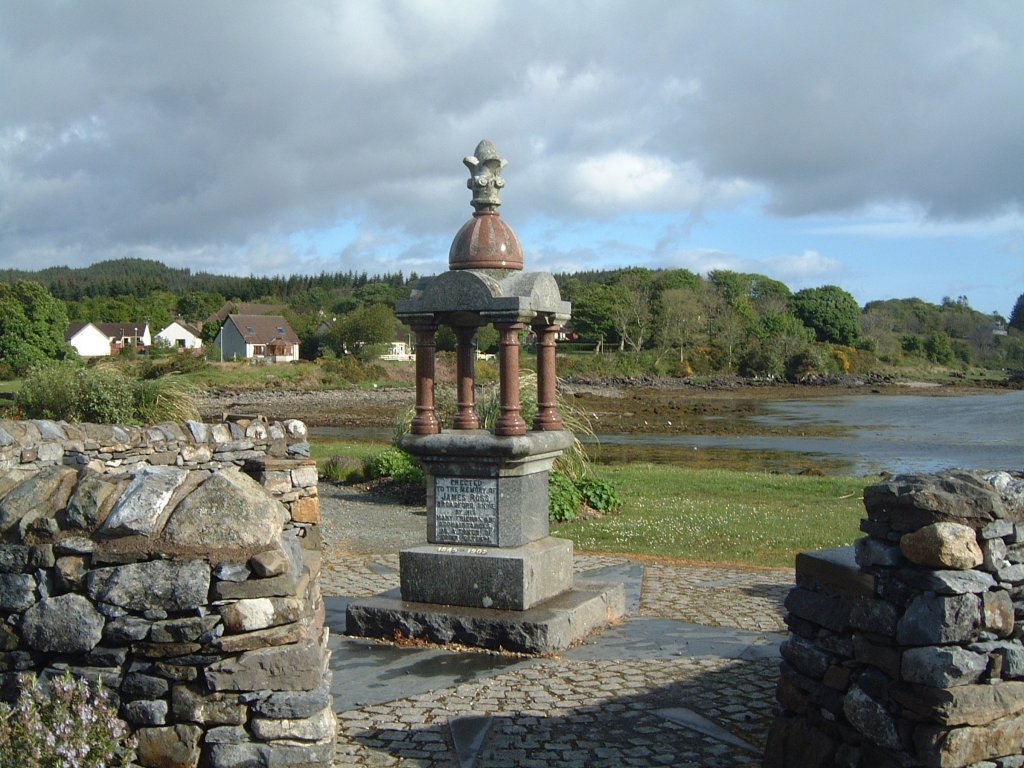
The Ross Fountain
(From the Canadian Massed Pipes & Drums Tour of 2009)
The fountain was cast in iron by Durenne of Paris for an International Exhibition in Paris in 1862. When gunsmith Daniel Ross saw it, he purchased it and donated it to the City of Edinburgh in 1867. It was shipped to Leith in 122 pieces then transferred by road the three miles to Princes Street Gardens, Edinburgh. It was still awaiting assembly in Princes Street Gardens when Daniel Ross died in 1871.
The statue was described as "having 4 female figures ; seated between them semi-circular basins with consoles, surmounted by a standing figure above the basins and nymphs". An article in 1869 described it as "one of the most elaborate and ornate structures of its class in Europe". In 1990 the fountain was restored so that it had flowing water. 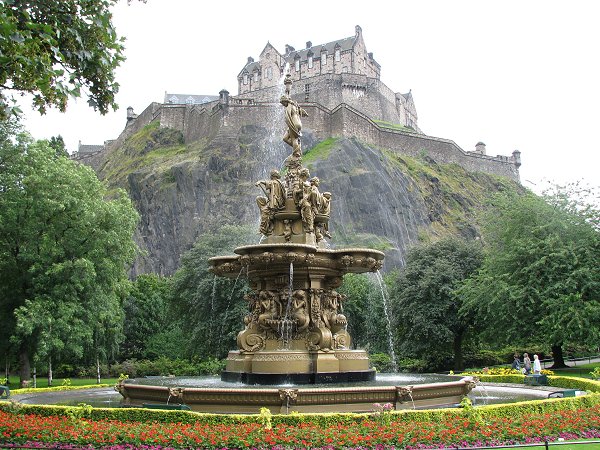
The DNA Dichotomy
Not your typical Scottish icon, an extraordinary east-west genetic divide was discovered in northern Scotland by Edinburgh University's Dr. Jim Wilson and St. Andrews University's Alistair Moffat. Not only did the study reveal proof of the ancient movement of people from Ireland to Scotland within the genetic signature, but they also concluded that "as many as 40% of the population on the Western Isles could have Viking ancestry, while no Viking ancestry was found in north east Scotland". In other words, they found a representative/characteristic symbol of the Scottish genealogical heritage of groups such as Clan Ross.
Where do we come from? Africa is the answer. "In 70,000 BC the Indonesian volcano known as Mount Toba blew itself apart in a super-colossal eruption that almost ended life on earth. As millions of tons of tephra, pumice and ash rocketed into the atmosphere and dense black clouds blocked the sun for several years, plants withered and the animals and people who depended on them died. Geography saved us from extinction. In the steep-sided rift valleys of Eastern Africa a remnant of perhaps only 5,000 human beings survived the nuclear horrors of the eruption. All of us are their descendants. Soon after the cataclysm of Toba, as the planet began to recover, a tiny group of only three or four hundred left the sanctuary of the rift valleys and walked northwards." From a sample of saliva scientists can trace your ancestry. All you need to do is to visit Family Tree DNA on our page of Links To All Things Scottish for starters. |

